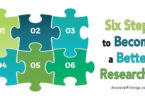If you've ever looked at online family trees or family trees in professional genealogy books or other publications, you have probably seen numbers by the names of individuals on the trees. While there are a few different methods for numbering your genealogy, all of the numbering systems have one purpose… to help you keep things organized so you can easily find and identify individuals and their relationships to other individuals on your family tree. Most numbering systems display in the order of the descendants of a given person, while the Ahnentafel system numbers people according to their ancestry to a certain individual.
Here are the most common genealogical numbering systems and how to use them.
Ahnentafel
The Ahnentafel is an ancestry chart, showing the ancestors of a particular person. The word itself is German for “ancestor table.” You can include a lot of information in a small amount of space using this numbering system.
Basically, you start out with one main person. That person is numbered as “1” on the chart. That person's parents are next, with the father being “2” and the mother being “3.” From now on, the ancestors on the father's side will always come before the ancestors on the mother's side, but they will all be included on the chart. The paternal grandfather is number 4, the paternal grandmother is 5, the maternal grandfather is 6, the maternal grandmother is 7, and so on.
You can take the Ahnentafel back as far as you like, or as far as you have information. After the grandparents, add the parents of the paternal grandfather (numbers 8 and 9), the parents of the paternal grandmother (10 and 11), then the maternal great-grandparents, and so on, numbering accordingly as you go back in time on the chart.
The Register Numbering System
This is the descendancy numbering system used by the New England Historic and Genealogical Society and is often used in genealogical publications. It only includes blood-line descendants in the numbering, so spouses are not numbered.
The common ancestor whose descendants are being numbered is number one on the chart. The children of this person without known descendants are each given a lower-case Roman numeral in order of their birth. Children with known descendants are given a regular number according to their order of birth. These children will appear later in the report with their own children, who are also given the Roman numeral/regular number system, depending on their known descendants. Regular numbers should follow in normal order throughout the report as they are assigned. This way, only one person is assigned a particular number.
The Henry Numbering System
This numbering system is used in some genealogical books but is not accepted for genealogy magazines or for certification projects for the Board of Certification for Genealogists. It is a simplified numbering system that is used on descendant charts. The common ancestor is 1. The children are numbered according to birth order, beginning with number 11. The children of the children receive similar numbers. For example, the oldest child of the oldest child is 111. The second oldest is 112, and so on. The oldest child of the second oldest child is 121, then 122, 123, and so on.
When you use genealogical numbering to keep track of your family history research, you will also know who is who and how they are related to others in your family tree. Try using numbering in your own genealogy, and see how much more simplified it makes reading your family tree charts.




